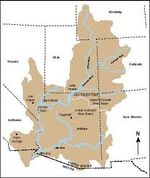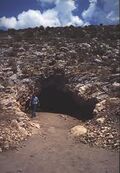Phoenicians
The Phoenicians were a tradespeople who lived in Phoenix, Arizona and the surrounding areas from 1550 BC to 300 BC. People in Phoenician civilizations were highly innovative for the time, as shown by their ability to adapt to their environment, which was often dry, with temperatures at or above 105 degrees Fahrenheit year-round. On the other hand, their culture was very underdeveloped compared to that of other early Middle West civilizations.
Civilization[edit]
The Phoenicians were noted for being far less civilized than the nearby Albequerqeans and Denverites, their two closest trade partners. Albequerquean and Denverite city-states, although a little white-trashy, were carefully governed, while Phoenician city-states were allowed to run completely out of control, as was hinted by the various beer bottles and cans that archeologists dug up. Another aspect of Phoenician civilization that is of note is the absurdly high population of the city-states, beating out the population of Denverite and Albequerquean civilization by millions. Historians have speculated that this lofty population statistic was a prime factor in the anarchy of Pheonician civilization, but this was due mainly to the nature of Phoenician people.
Phoenician people were a very unruly and unintelligent people, with one of the highest college dropout rates of all early Western World civilizations. They were topped only by Miamian people in this respect. Their crime rate, though also high, was decidedly lower than that of the Oaklandians, Camdenites and Detroitians. Still, the Phoenicians stand as one of the least organized civilizations of their time.
It should be noted, though, that the Phoenicians were very innovative in adapting to their scorching hot environment. They did so by wearing very little clothing, a strategy Albequerqueans never adapted. This method of adaptation is still used today.
Trade[edit]
The Phoenicians relied almost entirely on trade for income, food, and goods. Their primary trade partners were the Denverites, mainly because the two civilizations were connected by the Colorado River. Another factor that led to these two civilizations being such prevalent trade partners was the environment, which was decidedly different. For example, a cactus growing in Phoenix was worth much more in Denver, where it would never naturally grow due to the cold climate. Likewise, certain minerals from Denverite mountains were of much higher value in Phoenix than in Denver.
Another trade partner that often transacted with the Phoenicians were the Albequerqueans, primarily because Albequerque was a much more prosperous civilization than Phoenix. What was from Phoenix was incredibly cheap in Albequerque, and what was from Albequerque was a coveted item in Phoenix. Because these two civilizations were very similar in terms of goods, this created an imbalance of wealth in both Phoenician and Albequerquean society.
Culture[edit]
The Phoenicians placed little emphasis on culture, unlike most civilizations of the time. Historians speculate that Phoenician families were divided by conflict between the husband and wife most of the time, probably because of the adulterous nature of Phoenician men. Phoenician women were regarded as lower-class citizens, and when they disobeyed a man's rules, they were often beaten or traded for the much-prettier Denverite women.
Phoenician children were supposed to be seen, not heard, and were also beaten or traded when they disregarded the rules they were required to follow. Often times, young Phoenician women would be sold into prostitution, and then traded if they failed to perform consistently.
Phoenician society, however, did have religious beliefs; artifacts such as whiskey bottles and condoms have been found at supposed sites of religious rituals.
Education[edit]
Phoenix was notorious for having horrible education, with the average GPA of a top student being about 0.7. Phoenician classrooms rarely had teachers, and when they did, the teacher was often a cactus imported from Albequerque. Classes were usually held inside huts and underground tunnels, the largest of these tunnels being the University of Phoenix and the University of Arizona, respectably.
The University of Arizona in particular was considered one of the worst schools in the world at the time. Students hardly ever went to classes; instead, they engaged in acts of fornication with other university students. This was a trend that continued for years, and soon spread to other schools such as the University of Miami.


